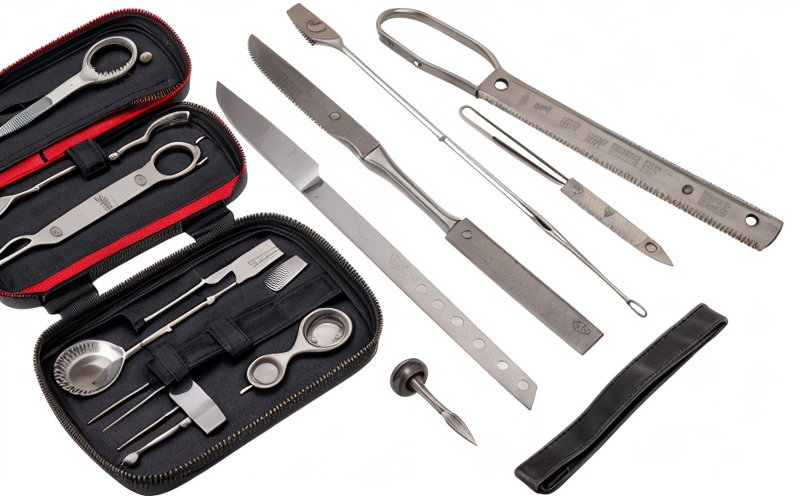Flexural Testing of Surgical Probes
The flexural testing of surgical probes is a critical aspect of ensuring the safety and efficacy of medical devices. Flexural strength tests are essential in evaluating how well these delicate instruments withstand mechanical stress without failure during use. This service is particularly important for surgical probes, which are subject to significant forces due to their design and intended application.
These probes often come into contact with human tissue and must be robust enough to perform their functions accurately while minimizing the risk of injury or damage to the patient. The flexural testing process involves applying a specified load to the probe until it bends beyond its elastic limit, at which point permanent deformation occurs or fracture happens.
Accurate measurement during this test is crucial for understanding the material properties and structural integrity of the surgical probes. Compliance with international standards such as ISO 10993-1 (Biocompatibility - Evaluation and Testing) ensures that manufacturers adhere to stringent quality control measures. By conducting these tests, we ensure not only regulatory compliance but also enhance patient safety by validating the robustness of medical devices.
The testing process typically starts with carefully selecting samples from each batch produced by the manufacturer. These samples undergo rigorous preparation before being placed into a specialized flexural testing machine designed specifically for this purpose. The setup involves securing one end of the probe while applying force at the other end until failure occurs or maximum deflection is reached.
Understanding the specific requirements for different types of probes helps tailor the test parameters accordingly. For instance, probes used in minimally invasive surgeries may require higher precision and less force to avoid causing harm during insertion or manipulation inside the body. Conversely, those employed in open surgical procedures might need more robust construction capable of withstanding greater loads.
After completing each series of tests, comprehensive reports are generated detailing the results obtained from various measurements taken throughout the process. These documents serve as valuable references for quality assurance teams and engineers involved in product development cycles. They also provide critical information necessary for troubleshooting any issues encountered during manufacturing processes or design iterations aimed at improving future generations of surgical probes.
In summary, flexural testing plays a vital role in guaranteeing that medical devices like surgical probes meet stringent safety standards while maintaining optimal performance levels under expected operating conditions.
Why It Matters
The importance of flexural testing extends beyond mere compliance with regulatory requirements; it directly impacts patient care and overall healthcare outcomes. Ensuring that every surgical probe is capable of enduring the stresses encountered during use reduces the likelihood of complications such as tool breakage or improper function within the body.
- Improved Patient Safety: By confirming that probes can withstand required forces without damage, we minimize risks associated with potential failure during critical procedures.
- Risk Reduction: Flexural testing helps identify design flaws early in the development cycle, allowing manufacturers to address them proactively rather than reactively after a product has been introduced into clinical settings.
- Ethical Responsibility: Adhering to rigorous testing protocols demonstrates our commitment to producing high-quality medical devices that contribute positively to patient welfare.
In addition, this service supports continuous improvement efforts by providing actionable insights based on empirical data collected during each test. This information can be used by researchers and clinicians alike to inform decisions regarding new designs or modifications aimed at enhancing functionality or usability without compromising safety standards.
Scope and Methodology
The scope of flexural testing for surgical probes encompasses a range of parameters that must be carefully controlled to ensure accurate results. This includes specifying the type of material used in constructing the probe, determining appropriate load ranges based on expected usage scenarios, selecting suitable fixtures capable of holding the specimen securely during testing, and establishing acceptable limits for deflection or fracture.
Once these factors have been defined, the actual process begins by positioning one end of the probe between two jaws fixed onto a machine designed specifically for this purpose. A controlled force is then applied gradually until either the probe bends beyond its elastic limit or breaks entirely. Throughout this procedure, precise measurements are taken to monitor both displacement and stress levels.
After collecting all necessary data points, an analysis is performed using statistical methods to determine whether the probe meets specified criteria established by relevant standards organizations. If any discrepancies arise between actual performance versus expected outcomes, further investigation into potential causes might be warranted until satisfactory results can be achieved consistently across multiple samples.
Environmental and Sustainability Contributions
The field of medical device testing, including flexural testing for surgical probes, contributes positively to both environmental sustainability and broader societal goals. Through meticulous evaluation of materials and processes employed in manufacturing these devices, we help reduce waste generation throughout the product lifecycle.
- Material Efficiency: By identifying optimal material compositions early in the design stage, manufacturers can minimize resource consumption without sacrificing quality or performance capabilities.
- Energy Savings: Advanced testing techniques enable more efficient use of energy resources during production runs by optimizing tool settings and minimizing unnecessary rework cycles.
- Eco-Friendly Packaging: Testing results guide the development of eco-friendly packaging solutions that protect products during shipping while reducing environmental impact.
Beyond these direct benefits, our commitment to excellence in medical device testing fosters innovation across various disciplines involved in healthcare delivery systems. As industries continue evolving towards greener practices, laboratories like ours play a pivotal role in driving positive change through cutting-edge research and development activities focused on sustainable solutions for tomorrow's challenges.





